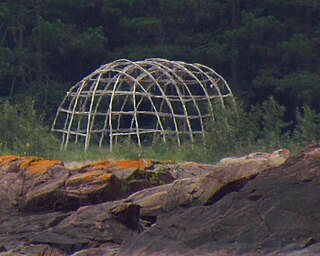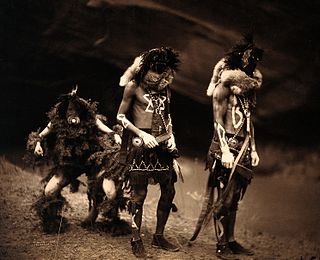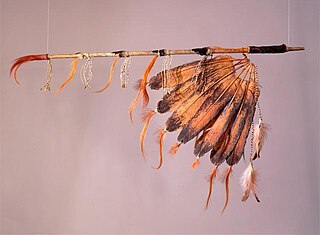Related Research Articles

The Sioux or Oceti Sakowin are groups of Native American tribes and First Nations peoples in North America. The modern Sioux consist of two major divisions based on language divisions: the Dakota and Lakota; collectively they are known as the Očhéthi Šakówiŋ. The term "Sioux" is an exonym created from a French transcription ("Nadouessioux") of the Ojibwe term "Nadowessi", and can refer to any ethnic group within the Great Sioux Nation or to any of the nation's many language dialects.

The Cheyenne are an Indigenous people of the Great Plains. Their Cheyenne language belongs to the Algonquian language family. Today, the Cheyenne people are split into two federally recognized nations: the Southern Cheyenne, who are enrolled in the Cheyenne and Arapaho Tribes in Oklahoma, and the Northern Cheyenne, who are enrolled in the Northern Cheyenne Tribe of the Northern Cheyenne Indian Reservation in Montana. The Cheyenne comprise two Native American tribes, the Só'taeo'o or Só'taétaneo'o and the Tsétsêhéstâhese. The tribes merged in the early 19th century.

A sweat lodge is a low profile hut, typically dome-shaped or oblong, and made with natural materials. The structure is the lodge, and the ceremony performed within the structure may be called by some cultures a purification ceremony or simply a sweat. Traditionally the structure is simple, constructed of saplings covered with blankets and sometimes animal skins. The sweat is a spiritual ceremony – it is for prayer and healing, and it is only to be led by Indigenous Elders who know the language, songs, traditions, and safety protocols of their culture's inherited tradition. Otherwise, the ceremony can be dangerous if performed improperly.

A kachina is a spirit being in the religious beliefs of the Pueblo people, Native American cultures located in the south-western part of the United States. In the Pueblo cultures, kachina rites are practiced by the Hopi, Hopi-Tewa and Zuni peoples and certain Keresan tribes, as well as in most Pueblo tribes in New Mexico.

Sitting Bull was a Hunkpapa Lakota leader who led his people during years of resistance against United States government policies. He was killed by Indian agency police on the Standing Rock Indian Reservation during an attempt to arrest him, at a time when authorities feared that he would join the Ghost Dance movement.

The Ghost Dance was a ceremony incorporated into numerous Native American belief systems. According to the teachings of the Northern Paiute spiritual leader Wovoka, proper practice of the dance would reunite the living with spirits of the dead, bring the spirits to fight on their behalf, end American Westward expansion, and bring peace, prosperity, and unity to Native American peoples throughout the region.

A tipi, often called a lodge in English, is a conical tent, historically made of animal hides or pelts, and in more recent generations of canvas, stretched on a framework of wooden poles. The word is Siouan, and in use in Dakhótiyapi, Lakȟótiyapi, and as a loanword in US and Canadian English, where it is sometimes spelled phonetically as teepee and tepee.

John Fire Lame Deer was a Lakota holy man, member of the Heyoka society, grandson of the Miniconjou head man Lame Deer, and father of Archie Fire Lame Deer.

Plains Indians or Indigenous peoples of the Great Plains and Canadian Prairies are the Native American tribes and First Nation band governments who have historically lived on the Interior Plains of North America. While hunting-farming cultures have lived on the Great Plains for centuries prior to European contact, the region is known for the horse cultures that flourished from the 17th century through the late 19th century. Their historic nomadism and armed resistance to domination by the government and military forces of Canada and the United States have made the Plains Indian culture groups an archetype in literature and art for Native Americans everywhere.

The heyoka is a kind of sacred clown in the culture of the Sioux of the Great Plains of North America. The heyoka is a contrarian, jester, and satirist, who speaks, moves and reacts in an opposite fashion to the people around them. Only those having visions of the thunder beings of the west, the Wakíŋyaŋ, and who are recognized as such by the community, can take on the ceremonial role of the heyoka.

The Sun Dance is a ceremony practiced by some Native Americans in the United States and Indigenous peoples in Canada, primarily those of the Plains cultures. It usually involves the community gathering together to pray for healing. Individuals make personal sacrifices on behalf of the community.

War bonnets are feathered headgear traditionally worn by male leaders of the American Plains Indians Nations who have earned a place of great respect in their tribe. Originally they were sometimes worn into battle, but they are now primarily used for ceremonial occasions. In the Native American and First Nations communities that traditionally have these items of regalia, they are seen as items of great spiritual and political importance, only to be worn by those who have earned the right and honour through formal recognition by their people.
Clown society is a term used in anthropology and sociology for an organization of comedic entertainers who have a formalized role in a culture or society.

The Pueblo clowns are jesters or tricksters in the Kachina religion. It is a generic term, as there are a number of these figures in the ritual practice of the Pueblo people. Each has a unique role; belonging to separate Kivas and each has a name that differs from one mesa or pueblo to another.

Čhetáŋ Sápa' (Black Hawk) (c. 1832 – c. 1890) was a medicine man and member of the Sans Arc or Itázipčho band of the Lakota people. He is most known for a series of 76 drawings that were later bound into a ledger book that depicts scenes of Lakota life and rituals. The ledger drawings were commissioned by William Edward Canton, a federal "Indian trader" at the Cheyenne River Indian Reservation. Black Hawk's drawings were drawn between 1880-1881. Today they are known as one of the most complete visual records of Lakota cosmology, ritual and daily life.
John Plant is an American ethnologist, biologist and expert on the culture of the Plains Indians.

Native American religions are the spiritual practices of the Native Americans in the United States. Ceremonial ways can vary widely and are based on the differing histories and beliefs of individual nations, tribes and bands. Early European explorers describe individual Native American tribes and even small bands as each having their own religious practices. Theology may be monotheistic, polytheistic, henotheistic, animistic, shamanistic, pantheistic or any combination thereof, among others. Traditional beliefs are usually passed down in the forms of oral histories, stories, allegories, and principles.

Two-spirit is a modern, pan-Indian umbrella term used by some Indigenous North Americans to describe Native people in their communities who fulfill a traditional third-gender ceremonial and social role in their cultures.

A ceremonial pipe is a particular type of smoking pipe, used by a number of cultures of the indigenous peoples of the Americas in their sacred ceremonies. Traditionally they are used to offer prayers in a religious ceremony, to make a ceremonial commitment, or to seal a covenant or treaty. The pipe ceremony may be a component of a larger ceremony, or held as a sacred ceremony in and of itself. Indigenous peoples of the Americas who use ceremonial pipes have names for them in each culture's Indigenous language. Not all cultures have pipe traditions, and there is no single word for all ceremonial pipes across the hundreds of diverse Native American languages.
Lakota religion or Lakota spirituality is the traditional Native American religion of the Lakota people. It is practiced primarily in the Lakota reservations of the North American Plains. The tradition has no formal leadership and displays much internal variation.
References
- 1 2 3 4 5 Plant, John (2010). The Plains Indian Clowns, their Contraries and related Phenomena (PDF). Vienna. Retrieved 19 December 2010.
{{cite book}}: CS1 maint: location missing publisher (link) - 1 2 3 Plant, John (1994). Heyoka: Die Contraries und Clowns der Plainsindianer[Hekoya: The contraries and clowns of the plains Indians]. Verlag für Amerikanistik. Wyk auf Foehr.
- ↑ Steward, Julian (1930). "The ceremonial buffoon of the American Indian". Papers of the Michigan Academy of Science, Arts, and Letters. Michigan Academy of Science, Arts and Letters (14): 187–207.
- ↑ Ray, Verne (Spring 1945). "The contrary behavior pattern in American Indian ceremonialism". Southwestern Journal of Anthropology. 1 (1): 75–113. doi:10.1086/soutjanth.1.1.3628784. JSTOR 3628784. S2CID 193093963.